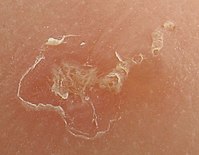
Photo from wikipedia
Mosquito bites are endured by most populations worldwide. Reactions to mosquito bites range from localized wheals and papules with associated pruritus to rare systemic reactions and anaphylaxis in certain populations.… Click to show full abstract
Mosquito bites are endured by most populations worldwide. Reactions to mosquito bites range from localized wheals and papules with associated pruritus to rare systemic reactions and anaphylaxis in certain populations. The mechanism of itch is due to introduction of mosquito saliva components into the cutaneous tissue, although the exact pathophysiology is unclear. Histamine is thought to be a key player through mosquito saliva itself or through activation of mast cells by IgE or through an IgE-independent pathway. However, other salivary proteins such as tryptase and leukotrienes may induce non-histaminergic itch. Some individuals have a genetic predisposition for mosquito bites, and people with hematologic cancers, HIV, and other conditions are susceptible to robust reactions. Prevention of mosquito bites is key with physical barriers or chemical repellents. Treatment consists of second-generation antihistamines and topical corticosteroids. Further research on topical treatments that target neural-mediated itch is needed.
Journal Title: Frontiers in Immunology
Year Published: 2022
Link to full text (if available)
Share on Social Media: Sign Up to like & get
recommendations!